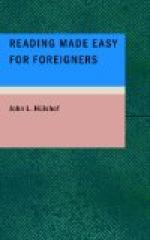COFFEE
Coffee is made from the berries of a tree called the coffee plant, or coffee tree. This tree grows in some of the hot countries of the world, as Brazil, Cuba, Arabia, and Java. The best coffee comes from Arabia. But most of the coffee that is used in this country comes from Brazil.
When first known, the coffee tree was a wild shrub growing among the hills of Caffa, in the northeastern part of Africa. But when people learned what a pleasant drink could be made from its berries, they began to take it into other countries, where they cultivated it with much care.
There is an old story told of a shepherd who, it is said, was the first to use this drink. He noticed that after his goats had fed on the leaves of a certain tree—the coffee plant—they were always very lively and wakeful. So he took some of the leaves and berries of the plant, and boiling them in water, he made a drink for himself. He found it so pleasant to the taste that he told some of his neighbors about it. They tried it and were as much pleased as himself. And so, little by little, the drink came, after a while, into common use.
The coffee plant is a beautiful little tree, growing sometimes to the height of twenty feet. It has smooth, dark leaves, long and pointed. It has pretty, white blossoms, which grow in thick clusters close to the branches. Its fruit looks a little like a cherry; and within it are the coffee berries, two in each cherry.
When ripe, the red fruit turns to a deep purple and is sweet to the taste. In Arabia the fruit is allowed to fall on mats placed under the trees; but in other countries it is commonly gathered as soon as it is ripe, and it is then dried by being placed on mats in the sun.
After the outside part has been removed the berries are again dried. They are then put in sacks and boxes to be sent into other parts of the world.
LESSON IV
OUR NATIONAL FLAG
There is a national flag. He must be cold indeed who can look upon its folds rippling in the breeze without pride of country. If he be in a foreign land, the flag is companionship and country itself with all its endearments. Who, as he sees it, can think of a state merely? Whose eyes, once fastened upon it, can fail to recognize the image of the whole nation? It has been called a “floating piece of poetry.”
Its highest beauty is in what it symbolizes. It is because it represents all, that all gaze at it with delight and reverence. It is a piece of bunting lifted in the air, but it speaks sublimely, and every part has a voice. Its stripes of alternate red and white proclaim the original union of thirteen states. Its stars of white on a field of blue proclaim the union of the states. A new star is added with every new state. The very colors have a language, which was understood by our fathers.




